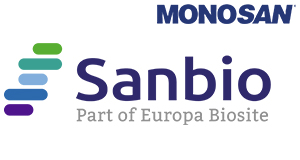Anti-GFAP Antibody Picoband™ (monoclonal, 3F2)
Anti-GFAP Antibody Picoband™ (monoclonal, 3F2)
SKU
SANMON23706
Packaging Unit
100μg
Manufacturer
Sanbio / Monosan
Availability:
loading...
Price is loading...
Clone Number: 3F2
Immunogen: E.coli-derived human GFAP recombinant protein (Position: Q93-M432). Human GFAP shares 94% amino acid (aa) sequence identity with both mouse and rat GFAP.
Concentration: Adding 0.2 ml of distilled water =f 500 μg/ml.
Format: Lyophilized
Storage buffer: Each vial contains 4mg Trehalose, 0.9mg NaCl, 0.2mg Na2HPO4, 0.05mg NaN3.
Additional info: Store at -20˚C for one year from date of receipt. After reconstitution, at 4˚C for one month. It can also be aliquotted and stored frozen at -20˚C for six months. Avoid repeated freeze-thaw cycles.Add 0.2ml of distilled water will yield a concentration of 500μg/ml. Background: Glial fibrillary acidic protein (GFAP) is a protein that is encoded by the GFAP gene in humans. It is an intermediate filament (IF) protein that is expressed by numerous cell types of the central nervous system (CNS) including astrocytes, and ependymal cells. It is mapped to 17q21.31. GFAP is closely related to its non-epithelial family members, vimentin, desmin, and peripherin, which are all involved in the structure and function of the cell’s cytoskeleton. GFAP is thought to help to maintain astrocyte mechanical strength, as well as the shape of cells. This gene has been shown to play a role in mitosis by adjusting the filament network present in the cell. GFAP is necessary for many critical roles in the CNS. What’s more, GFAP also plays a role in astrocyte-neuron interactions as well as cell-cell communication. Subcellular Localization: Tissue Specificity:
Immunogen: E.coli-derived human GFAP recombinant protein (Position: Q93-M432). Human GFAP shares 94% amino acid (aa) sequence identity with both mouse and rat GFAP.
Concentration: Adding 0.2 ml of distilled water =f 500 μg/ml.
Format: Lyophilized
Storage buffer: Each vial contains 4mg Trehalose, 0.9mg NaCl, 0.2mg Na2HPO4, 0.05mg NaN3.
Additional info: Store at -20˚C for one year from date of receipt. After reconstitution, at 4˚C for one month. It can also be aliquotted and stored frozen at -20˚C for six months. Avoid repeated freeze-thaw cycles.Add 0.2ml of distilled water will yield a concentration of 500μg/ml. Background: Glial fibrillary acidic protein (GFAP) is a protein that is encoded by the GFAP gene in humans. It is an intermediate filament (IF) protein that is expressed by numerous cell types of the central nervous system (CNS) including astrocytes, and ependymal cells. It is mapped to 17q21.31. GFAP is closely related to its non-epithelial family members, vimentin, desmin, and peripherin, which are all involved in the structure and function of the cell’s cytoskeleton. GFAP is thought to help to maintain astrocyte mechanical strength, as well as the shape of cells. This gene has been shown to play a role in mitosis by adjusting the filament network present in the cell. GFAP is necessary for many critical roles in the CNS. What’s more, GFAP also plays a role in astrocyte-neuron interactions as well as cell-cell communication. Subcellular Localization: Tissue Specificity:
| SKU | SANMON23706 |
|---|---|
| Manufacturer | Sanbio / Monosan |
| Manufacturer SKU | MON23706 |
| Package Unit | 100μg |
| Quantity Unit | STK |
| Reactivity | Human, Mouse (Murine), Rat (Rattus) |
| Clonality | Monoclonal |
| Application | Immunofluorescence, Western Blotting, Immunohistochemistry |
| Isotype | IgG1 |
| Host | Mouse |
| Conjugate | Unconjugated |
| Product information (PDF) |
|
| MSDS (PDF) |
|

 Deutsch
Deutsch







